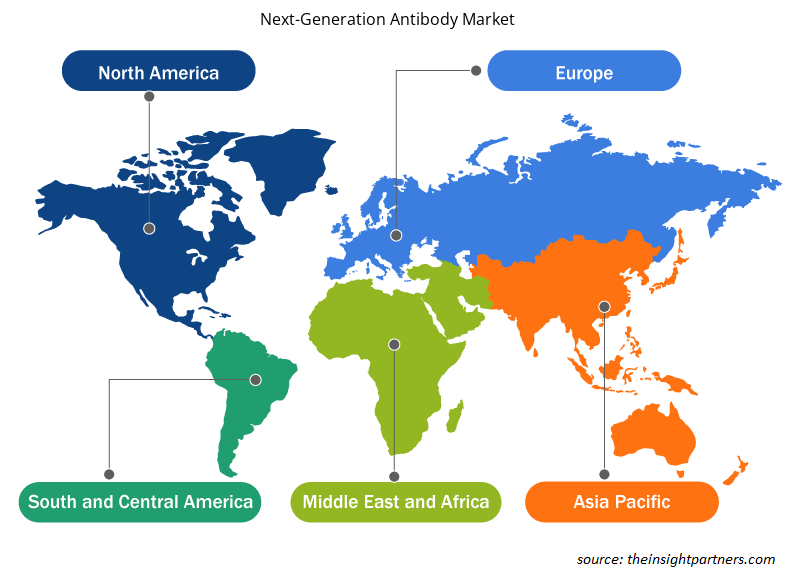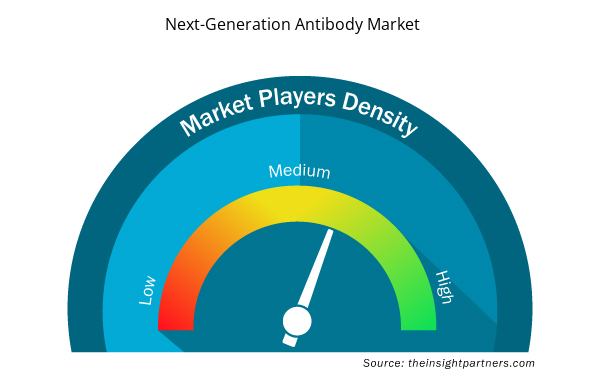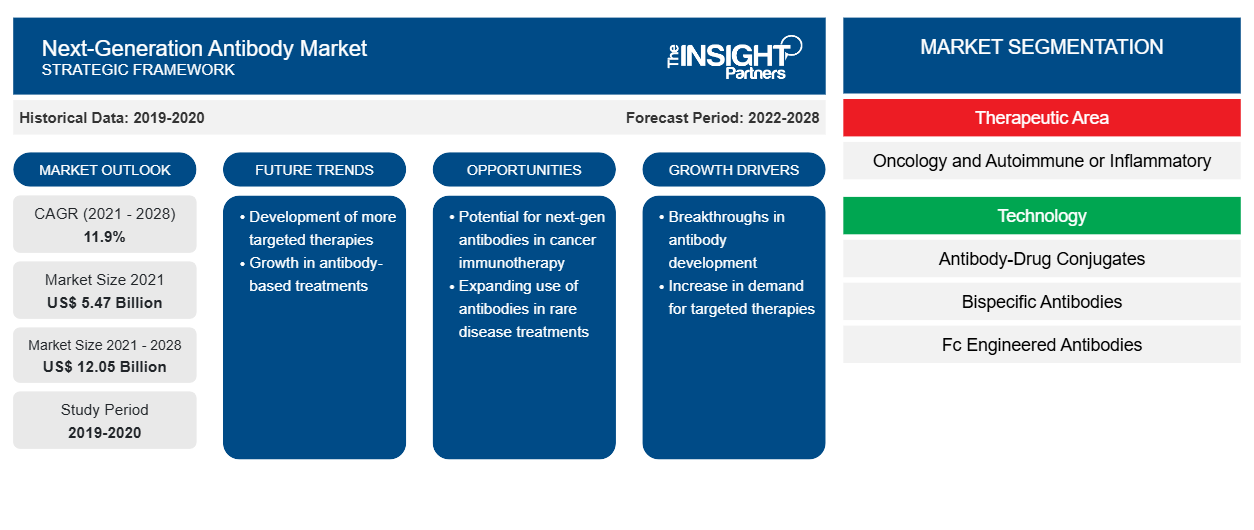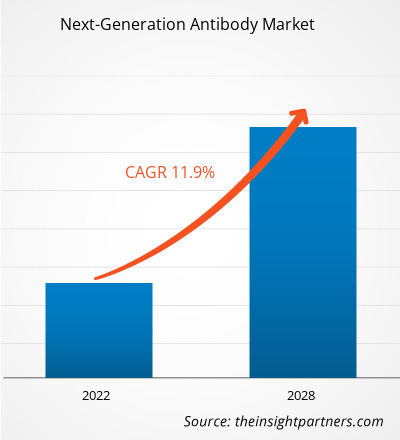次世代抗体市場は、2021年の54億6,841万米ドルから2028年には120億5,013万米ドルに達すると予想されており、2021年から2028年にかけて11.9%のCAGRで成長すると予測されています。
次世代抗体は、従来のモノクローナル抗体よりも特異性が高く、多くの場合、より強力になるように設計されています。次世代抗体戦略は、安定性、標的送達、およびオフターゲット効果の制限を確保しながら、抗体、ペイロード、リンカー、および結合方法を組み合わせた有用な治療薬を設計するために必要です。
このレポートは、次世代抗体市場に関する洞察と詳細な分析を提供し、市場動向、技術の進歩、市場のダイナミクス、世界中の主要な市場プレーヤーの競合状況分析など、さまざまなパラメーターに重点を置いています。また、すべての地域の市場に対するCOVID-19パンデミックの影響も含まれています。パンデミックは、世界中のさまざまな国の社会経済的状況を混乱させました。最近のWHOの統計によると、現在、米国はCOVID-19の発生により、確認された症例数と死亡者数が世界で最も多く、世界で最も影響を受けている国です。COVID-19陽性症例の数が多いことは、世界経済に悪影響を及ぼしています。世界中で事業活動全体が低下し、さまざまな産業が成長しています。
要件に合わせてレポートをカスタマイズする
このレポートの一部、国レベルの分析、Excelデータパックなど、あらゆるレポートを無料でカスタマイズできます。また、スタートアップや大学向けのお得なオファーや割引もご利用いただけます。
- このレポートの主要な市場動向を入手してください。この無料サンプルには、市場動向から見積もりや予測に至るまでのデータ分析が含まれます。
COVID-19の流行は、米国、カナダ、メキシコの医療インフラに多大な負担をかけています。また、ほとんどの製薬企業やバイオテクノロジー企業、研究機関は、COVID-19のワクチンや治療薬の開発に取り組んでいます。定評のある製薬企業と小規模なスタートアップ企業の両方が、新型コロナウイルスによって引き起こされる感染症を標的とした治療法やワクチンの開発に取り組んでいます。その結果、製薬企業やバイオテクノロジー企業、研究センター、教育研究機関でのワクチン関連の研究活動は不可欠であると認識されており、運営や成果にはほとんど影響がありません。ただし、研究活動の増加により、分析のための資金のアクセス可能性と、次世代抗体を含む抗体の必要性の両方が増加すると予想されます。さらに、COVID-19の流行を先導して、世界中の多くの研究者がCOVID-19を発症させるウイルスであるSARS-CoV-2のウイルス検査に取り組んでいます。ワクチンと治療薬の両方で、生成された抗体が標的ウイルスに対抗する機能効率を検査します。したがって、COVID-19パンデミックは今後数年間で次世代抗体市場にプラスの影響を与えると予想されます。
地域別に見ると、次世代抗体市場は北米、ヨーロッパ、アジア太平洋、中東・アフリカ、中南米に分類されます。
市場分析
次世代抗体治療薬の需要増加が次世代抗体市場を牽引
バイオテクノロジーの発展により、次世代抗体治療薬の受け入れが拡大し、自己免疫疾患、炎症性疾患、慢性疾患の治療における使用が促進されています。次世代抗体治療は、抗体薬物複合体(ADC)、糖鎖工学抗体、特異的抗体(BsAbs)などの抗体治療薬における高度な技術の応用から生まれました。そのため、次世代抗体の応用は、がん、HIV、感染症などのさまざまな慢性疾患の治療に広く研究されています。これらの抗体の需要の高まりにより、ADCやその他の次世代抗体治療薬の承認が急速に増加しています。たとえば、2020年5月、武田薬品工業株式会社は、FDA承認の検査で未分化リンパ腫キナーゼ陽性(ALK +)転移性非小細胞肺がん(NSCLC)が検出された成人患者を対象に、ALUNBRIG(ブリガチニブ)のFDA承認を発表しました。 ALUNBRIG の現在の適応症は、承認により第一選択薬にまで拡大されました。ALUNBRIG は、ALK 分子異常を標的とする次世代チロシンキナーゼ阻害剤 (TKI) です。同様に、ジェネンテックは 2019 年に、再発性または難治性のびまん性大細胞型 B 細胞リンパ腫の成人患者を対象に、ベンダムスチンおよびリツキシマブ製品との併用で適応となる CD79b 標的抗体薬物複合体であるポラツズマブ ベドチン-piiq の FDA 迅速承認を発表しました。
したがって、臨床試験の承認の増加と、さまざまな疾患の治療のための次世代抗体治療薬の採用率の高さにより、次世代抗体市場は予測期間中に急速に成長すると予想されます。
治療領域に基づく洞察
治療領域に基づいて、次世代抗体市場は腫瘍学と自己免疫または炎症に分かれています。腫瘍学セグメントが市場の大きなシェアを占めています。
テクノロジーに基づく洞察
技術に基づいて、次世代抗体市場は、抗体薬物複合体、二重特異性抗体、Fc改変抗体、抗体フラグメントと抗体様タンパク質、およびバイオシミラー抗体製品に分類されます。抗体薬物複合体セグメントは2021年に市場で最大のシェアを占め、同じセグメントは予測期間中に市場で最高のCAGR 12.1%を記録すると予測されています。
次世代抗体市場のプレーヤーは、製品の発売や拡張など、さまざまな有機的な戦略を採用して、世界中で事業展開と製品ポートフォリオを拡大し、高まる需要に応えています。
次世代抗体市場の地域別分析
予測期間を通じて次世代抗体市場に影響を与える地域的な傾向と要因は、Insight Partners のアナリストによって徹底的に説明されています。このセクションでは、北米、ヨーロッパ、アジア太平洋、中東およびアフリカ、南米および中米にわたる次世代抗体市場のセグメントと地理についても説明します。

- 次世代抗体市場の地域別データを入手
次世代抗体市場レポートの範囲
| レポート属性 | 詳細 |
|---|---|
| 2021年の市場規模 | 54億7千万米ドル |
| 2028年までの市場規模 | 120.5億米ドル |
| 世界のCAGR(2021年~2028年) | 11.9% |
| 履歴データ | 2019-2020 |
| 予測期間 | 2022-2028 |
| 対象セグメント | 治療領域別
|
| 対象地域と国 | 北米
|
| 市場リーダーと主要企業プロフィール |
|
市場プレーヤーの密度:ビジネスダイナミクスへの影響を理解する
次世代抗体市場は、消費者の嗜好の変化、技術の進歩、製品の利点に対する認識の高まりなどの要因により、エンドユーザーの需要が高まり、急速に成長しています。需要が高まるにつれて、企業は提供を拡大し、消費者のニーズを満たすために革新し、新たなトレンドを活用し、市場の成長をさらに促進しています。
市場プレーヤー密度とは、特定の市場または業界内で活動している企業または会社の分布を指します。これは、特定の市場スペースに、その市場規模または総市場価値に対してどれだけの競合相手 (市場プレーヤー) が存在するかを示します。
次世代抗体市場で活動している主要企業は次のとおりです。
- F. ホフマン・ラ・ロッシュ株式会社
- 協和キリン株式会社
- シーゲン株式会社
- イミュノジェン株式会社
- 武田薬品工業株式会社
免責事項:上記の企業は、特定の順序でランク付けされていません。

- 次世代抗体市場のトップキープレーヤーの概要を入手
企業プロフィール
- F. ホフマン・ラ・ロッシュ株式会社
- 協和キリン株式会社
- シーゲン株式会社
- イミュノジェン株式会社
- 武田薬品工業株式会社
- アムジェン株式会社
- ファイザー株式会社
- キャタレント株式会社
- アストラゼネカ
- ゼンコール
- 過去2年間の分析、基準年、CAGRによる予測(7年間)
- PEST分析とSWOT分析
- 市場規模価値/数量 - 世界、地域、国
- 業界と競争環境
- Excel データセット


- Vessel Monitoring System Market
- Smart Locks Market
- Trade Promotion Management Software Market
- Mesotherapy Market
- Arterial Blood Gas Kits Market
- Biopharmaceutical Contract Manufacturing Market
- Authentication and Brand Protection Market
- Airline Ancillary Services Market
- Artificial Turf Market
- Electronic Health Record Market

Report Coverage
Revenue forecast, Company Analysis, Industry landscape, Growth factors, and Trends

Segment Covered
This text is related
to segments covered.

Regional Scope
North America, Europe, Asia Pacific, Middle East & Africa, South & Central America

Country Scope
This text is related
to country scope.
よくある質問
The global next-generation antibody market is expected to reach US$ 5,428.41 million in 2028 from US$ 12,050.13 million in 2021. The market is estimated to grow with a CAGR of 11.9% from 2021-2028.
The next-generation antibodies are used in the therapeutic areas- oncology and oncology, and autoimmune or inflammatory. Mostly, the next-generation antibodies are used in the oncology field. The oncology segment is likely to hold the largest share of the market in 2021. Moreover, the oncology segment is anticipated to register the highest CAGR in the market during the forecast period, due to the vast usage of next-generation antibodies for cancers, high volume consumption, and product innovation for this field
The disposable pipettes tips market majorly consists of players like F. HOFFMANN-LA ROCHE LTD., Kyowa Kirin Co., Ltd., Seagen Inc., ImmunoGen, Inc., Takeda Pharmaceutical Company Limited, Amgen Inc., Pfizer Inc., Catalent Inc, AstraZeneca, and Xencor among others.
The growth of the market is attributed to the increasing prevalence of cancer and growing demand for next-generation antibody therapeutics drives the market growth. However, the complications associated with the manufacturing and approvals hampers the market growth.
The Asia Pacific registered as the fastest-growing region in the global next-generation antibody market. The market in this region is expected to grow significantly in countries such as China, Japan, and India. The market is driven by growing investments from international players in China and India, improving government support in countries such as China, expanding R&D, and advancing healthcare infrastructure. Therefore, the region holds huge potential for the next-generation antibody market players to grow during the forecast period.
Trends and growth analysis reports related to Life Sciences : READ MORE..
The List of Companies - Next-generation Antibody Market
- F. HOFFMANN-LA ROCHE LTD.
- Kyowa Kirin Co., Ltd.
- Seagen Inc.
- ImmunoGen, Inc.
- Takeda Pharmaceutical Company Limited
- Amgen Inc.
- Pfizer Inc.
- Catalent Inc
- AstraZeneca
- Xencor
The Insight Partners performs research in 4 major stages: Data Collection & Secondary Research, Primary Research, Data Analysis and Data Triangulation & Final Review.
- Data Collection and Secondary Research:
As a market research and consulting firm operating from a decade, we have published and advised several client across the globe. First step for any study will start with an assessment of currently available data and insights from existing reports. Further, historical and current market information is collected from Investor Presentations, Annual Reports, SEC Filings, etc., and other information related to company’s performance and market positioning are gathered from Paid Databases (Factiva, Hoovers, and Reuters) and various other publications available in public domain.
Several associations trade associates, technical forums, institutes, societies and organization are accessed to gain technical as well as market related insights through their publications such as research papers, blogs and press releases related to the studies are referred to get cues about the market. Further, white papers, journals, magazines, and other news articles published in last 3 years are scrutinized and analyzed to understand the current market trends.
- Primary Research:
The primarily interview analysis comprise of data obtained from industry participants interview and answers to survey questions gathered by in-house primary team.
For primary research, interviews are conducted with industry experts/CEOs/Marketing Managers/VPs/Subject Matter Experts from both demand and supply side to get a 360-degree view of the market. The primary team conducts several interviews based on the complexity of the markets to understand the various market trends and dynamics which makes research more credible and precise.
A typical research interview fulfils the following functions:
- Provides first-hand information on the market size, market trends, growth trends, competitive landscape, and outlook
- Validates and strengthens in-house secondary research findings
- Develops the analysis team’s expertise and market understanding
Primary research involves email interactions and telephone interviews for each market, category, segment, and sub-segment across geographies. The participants who typically take part in such a process include, but are not limited to:
- Industry participants: VPs, business development managers, market intelligence managers and national sales managers
- Outside experts: Valuation experts, research analysts and key opinion leaders specializing in the electronics and semiconductor industry.
Below is the breakup of our primary respondents by company, designation, and region:

Once we receive the confirmation from primary research sources or primary respondents, we finalize the base year market estimation and forecast the data as per the macroeconomic and microeconomic factors assessed during data collection.
- Data Analysis:
Once data is validated through both secondary as well as primary respondents, we finalize the market estimations by hypothesis formulation and factor analysis at regional and country level.
- Macro-Economic Factor Analysis:
We analyse macroeconomic indicators such the gross domestic product (GDP), increase in the demand for goods and services across industries, technological advancement, regional economic growth, governmental policies, the influence of COVID-19, PEST analysis, and other aspects. This analysis aids in setting benchmarks for various nations/regions and approximating market splits. Additionally, the general trend of the aforementioned components aid in determining the market's development possibilities.
- Country Level Data:
Various factors that are especially aligned to the country are taken into account to determine the market size for a certain area and country, including the presence of vendors, such as headquarters and offices, the country's GDP, demand patterns, and industry growth. To comprehend the market dynamics for the nation, a number of growth variables, inhibitors, application areas, and current market trends are researched. The aforementioned elements aid in determining the country's overall market's growth potential.
- Company Profile:
The “Table of Contents” is formulated by listing and analyzing more than 25 - 30 companies operating in the market ecosystem across geographies. However, we profile only 10 companies as a standard practice in our syndicate reports. These 10 companies comprise leading, emerging, and regional players. Nonetheless, our analysis is not restricted to the 10 listed companies, we also analyze other companies present in the market to develop a holistic view and understand the prevailing trends. The “Company Profiles” section in the report covers key facts, business description, products & services, financial information, SWOT analysis, and key developments. The financial information presented is extracted from the annual reports and official documents of the publicly listed companies. Upon collecting the information for the sections of respective companies, we verify them via various primary sources and then compile the data in respective company profiles. The company level information helps us in deriving the base number as well as in forecasting the market size.
- Developing Base Number:
Aggregation of sales statistics (2020-2022) and macro-economic factor, and other secondary and primary research insights are utilized to arrive at base number and related market shares for 2022. The data gaps are identified in this step and relevant market data is analyzed, collected from paid primary interviews or databases. On finalizing the base year market size, forecasts are developed on the basis of macro-economic, industry and market growth factors and company level analysis.
- Data Triangulation and Final Review:
The market findings and base year market size calculations are validated from supply as well as demand side. Demand side validations are based on macro-economic factor analysis and benchmarks for respective regions and countries. In case of supply side validations, revenues of major companies are estimated (in case not available) based on industry benchmark, approximate number of employees, product portfolio, and primary interviews revenues are gathered. Further revenue from target product/service segment is assessed to avoid overshooting of market statistics. In case of heavy deviations between supply and demand side values, all thes steps are repeated to achieve synchronization.
We follow an iterative model, wherein we share our research findings with Subject Matter Experts (SME’s) and Key Opinion Leaders (KOLs) until consensus view of the market is not formulated – this model negates any drastic deviation in the opinions of experts. Only validated and universally acceptable research findings are quoted in our reports.
We have important check points that we use to validate our research findings – which we call – data triangulation, where we validate the information, we generate from secondary sources with primary interviews and then we re-validate with our internal data bases and Subject matter experts. This comprehensive model enables us to deliver high quality, reliable data in shortest possible time.


 このレポートの無料サンプルを入手する
このレポートの無料サンプルを入手する